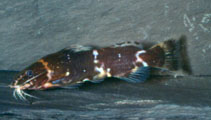| Family: |
Mochokidae (Squeakers or upside-down catfishes), subfamily: Mochokinae |
| Max. size: |
8.5 cm SL (male/unsexed) |
| Environment: |
demersal; freshwater; pH range: 6.80000019073486 - 7.5; dH range: 10 - 15 |
| Distribution: |
Africa: Ntem River in Gabon and Cameroon, and rivers Campo, Ivindo, Lobe, Nyong and Sanaga in Cameroon (Ref. 81251). Reports from the Congo basin are another species, probably referring to the valid M. christyi (Ref. 52369). |
| Diagnosis: |
Dorsal spines (total): 1. Diagnosis: dorsal and lateral surfaces of head with short tubercles in both sexes (not more than 0.1 mm long); dorsal spine gently curved; adipose fin very long, its base 34.4-41.6% SL; body without numerous dark brown elongate spots; caudal peduncle slender, its depth 5.8-9.2% SL; anterior edge of pectoral spine with antrorse serrations (Ref. 81251).
Description: body slender and elongate; snout length 42.1-48.9% SL; eye moderate, orbit diameter 14.7-19.6% SL; supracleithral process not reaching to vertical through posterior-most tip of nuchal shield; caudal fin rounded (Ref. 81251).
Coloration: adults (> 35 mm SL): dorsal and lateral surfaces of head and body brown, fading to cream or light greyish brown on ventral third of body, belly (with large faint brown spots) and ventral surface of head; snout with a series of cream spots delineating anterior and posterior nostrils, sometimes coalescing to form cream band running from anterior orbital margin to tip of snout; cheek with 1-2 cream spots immediately ventral to orbit; cream band encircling nape at supraoccipital; dorsal third of body with series of 4 cream vertical bar-shaped marks extending beyond mid-line of body: 1st at middle of dorsal fin base, 2nd mid-way between last dorsal fin ray and adipose fin origin, 3rd at middle of adipose fin base and last on caudal peduncle immediately posterior to adipose fin, sometimes encircling caudal peduncle as cream band; ventral third of flanks with a longitudinal series of 5-7 cream spots or vertical bar-shaped marks; dorsal, pectoral, pelvic and anal fin rays with brown spots arranged in 2-3 bands; caudal fin rays with brown spots arranged in 4 bands and hyaline interradial membranes; live colouration similar, with the addition of a faint dark reticulate pattern overlying the body (Ref. 81251). Juveniles (< 35 mm SL): similar, except for more prominent brown spotting on ventral surfaces and larger cream markings that sometimes assume more vermiform shapes, partially coalescing to form reticulate pattern; pectoral fins hyaline, with scattered brown spots; dorsal, anal and caudal fins with brown spots arranged in transverse bands (Ref. 81251). |
| Biology: |
Oviparous (Ref. 205). Maximum reported standard length 100mm (Ref. 3202). |
| IUCN Red List Status: |
Data deficient (DD); Date assessed: 16 February 2009 Ref. (130435)
|
| Threat to humans: |
harmless |
Source and more info: www.fishbase.org. For personal, classroom, and other internal use only. Not for publication.

